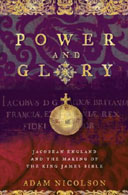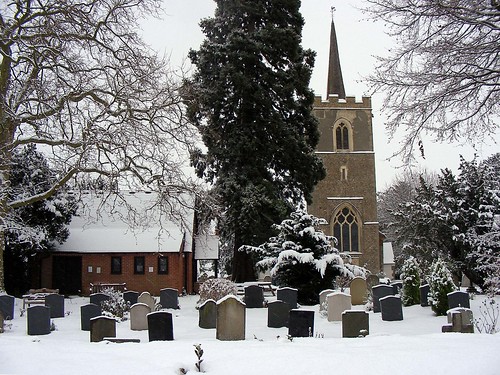William Tyndale - His influence on the KJV
povman.wordpress.comTyndale is the unsung hero:
Newspaper headlines still quote Tyndale, though unknowingly, and he has reached more people than even Shakespeare. (1)Really? Even more than Shakespeare? We are being taught to appreciate and revere the name of this unsung hero: see external links (at the foot).
How influential was he?
A writer in Contemporary Review says,
[Tyndale] is the mainly unrecognised translator of the most influential book in the world. Although the Authorised King James Version is ostensibly the production of a learned committee of churchmen, it is mostly cribbed from Tyndale with some reworking of his translation.
Describing their work as “cribbed” is inaccurate for two reasons: First, each KJV committee was led by a Director who was committed to ensure King James’ guidelines for translation were strictly followed. A foundation rule was that each translator make his own draft translation of a passage before it was discussed in committee, and that the final draft should then be compared with previous translations. Second, these articles have shown that the KJV translators were more than adequately equipped to make a scholarly and independent judgement, as to how to translate any word, phrase or sentence.
The Directors of the six translation committees working on a designated portion of the Text were men of great academic distinction: Lancelot Andrewes(Genesis - 2 Kings), William Barlow (Romans - Jude), John Harding (Isaiah - Malachi), Thomas Ravis
(Gospels, Acts, Apocalypse), Edward Lively/Laurence Chaderton (1 Chronicles - Ecclesiastes), and John Duport (Apocrypha). A ‘hyperlink-glance’ at their attainments should convince the reader that these Directors were able to ensure that the translation process, as guided by them, received the diligent thoroughness required by the King’s specific guidelines.
The flyleaf of most printings of the Authorized Version observes that the text had been "translated out of the original tongues, and with the former translations diligently compared and revised, by His Majesty's special command." James' instructions included several requirements that kept the new translation familiar to its listeners and readers. The text of the Bishops' Bible would serve as the primary guide for the translators, and the familiar proper names of the biblical characters would all be retained. If the Bishops' Bible
was inadequate, as was frequently the case, the translators were allowed to consult from a pre-approved list, the Tyndale Bible, the Coverdale Bible,Matthew's Bible, the Great Bible, and the Geneva Bible. Every verse of the Bible can readily be compared online, as between these and other Versions.
How much of the KJV is Tyndale’s work?
In answering this question, David Daniell accepts the work of Mormon writers Jon Nielson and Royal Skousen. They noted that previous estimates of Tyndale's contribution to the KJV 'have run from a high of up to 90% (Westcott) to a low of 18% (Butterworth)'. They tested this by using a statistically accurate and appropriate method of sampling - based on eighteen portions of the Bible - to show that Tyndale's contribution to the New Testament amounts to about 83% of the text, and in the Old Testament 76%.
What were William Tyndale’s linguistic skills?
Born in or around 1494, Tyndale’s life-aim from the age of ten(!) onwards was to translate the Bible into good English. All his energy was deliberately focused to achieve this aim. Tyndale showed an unusual aptitude for languages even as a child at Lady Berkeley's Grammar School at Wotton under Edge, where he learned to read Latin with ease. He went up to Oxford aged 12, where [so Foxe reports] ‘by long continuance he grew and increased in the knowledge of tongues and other liberal arts,’ and was ‘singularly addicted to the study of the Scriptures.’ By the time he was eighteen, William Hychyns (an alternative family name for Tyndale) graduated BA at Magdalen Hall, Oxford, in 1512. He sat at the feet of three great Christian humanists: William Grocyn, William Latimer and Thomas Linacre. Having been made MA three years later he began to study theology. Foxe records that he ‘read privily to certain students and fellows of Magdalen College some parcel of divinity, instructing them in the knowledge and truth of the scriptures’ (Foxe, ed. Pratt, 5.114–15).(4) Erasmus’ freshly published (1516) Greek NT may have been the foundation of these studies. Tyndale then went to Cambridge, where Greek studies had received a strong injection from the visit of Erasmus, who taught Greek there for several years while Tyndale was still at Oxford.
Arriving later in London (1523?) Tyndale sought to commend his scholarly aspirations to Cuthbert Tunstall, Bishop of London, so to obtain his help in publishing an English translation of the entire Bible. Tyndale had taken with him his translation of an oration of the Greek rhetorician Isocrates, with which to prove his highly-skilled attainments in Greek. He was later praised by the German scholar Hermann Buschius for his mastery of seven languages: Greek, Latin, Hebrew, German, Spanish, and French, as well as English.
Tyndale’s trail-blazing energy
William Tyndale published the entire New Testament in 1526/1535. He then translated and published the Pentateuch, and the book of Jonah. John Rogers continued Tyndale’s work after the latter’s martyrdom at the hands of Henry VIII.
The publication was called the Matthew’s Bible, in order to conceal from the authorities Tyndale’s posthumous involvement. What of the remainder of the Old Testament? David Daniell’s view is that, the Matthew Version containing the Books of Joshua, Judges, Ruth, First and Second Samuel, First and Second Kings, and First and Second Chronicles, were all William Tyndale‘s work. Tyndale worked directly from the Hebrew and Greek, occasionally consulting the Vulgate and Erasmus’s Latin version, and he used Luther's Bible for the prefaces, marginal notes and the biblical text. The remaining prophetic and poetic books of the Old Testament (and the Apocrypha) in the Matthew Bible were the work of Myles Coverdale. A. S. Herbert, Bible cataloguer, says of the Matthew Bible:
This version, which welds together the best work of Tyndale and Coverdale, is generally considered to be the real primary version of our English Bible upon which later editions were based, including the Geneva Bible and King James Version. Thus the Matthew Bible, though largely unrecognized, significantly shaped and influenced English Bible versions in the centuries that followed its first appearance. (2)
How did the KJV translators use earlier Versions?
The Bishops Bible was chosen to be the primary guide and orientation to spring-board a discussion, and a way of comparing a translators’ own first drafts. Nicolson gives a helpful example of how this worked by quoting Dr Ward Allen, who showed from a 1602 edition of the Bishops Bible how the revision worked. In this Bible, an individual translator has privately marked first suggestions for revision, ready for the impending weekly meeting with his colleagues. There his textual choices were aired, discussed and analysed.
Adam Nicolson's bookguardian.co.uk
A quotation follows, which illustrates using an example from Luke 1:57.
In Luke 1:57, the moment when Elizabeth, the mother of John the Baptist, the herald of Christ, gives birth, the Bishops’ Bible text reads:Elizabeth’s time came that she should bee delivered, and she brought forth a son.This, incidentally, is almost exactly the wording of William Tyndale’s 1526 New Testament. It is an uncomplicated and straightforward moment, almost certainly too prosaic for Jacobean taste, and, in one minute particular, inaccurate. The King James Translator on his own in his room marked the verse very carefully with Greek letters as follows:
kElizabeth’s time lcame that she should bee delivered, and she brought forth a son.and in the margin beside it wrote ‘k Now’ and ‘l was fulfilled’, with the intention presumably that the verse should read:Now Elizabeth‘s time was fulfilled that she should bee delivered, and she brought forth a son.That is the suggestion that he took to the weekly meeting. His co-Translators didn’t entirely like what he had done. They accepted his inclusion ‘Now’, translating a word which is in the Greek, and giving an extra flick of vitality and of conversational engagement to the verse, the storyteller drawing you in. But his other suggestion was rejected. The phrase ‘was fulfilled’ was a brave attempt at just the kind of lexical enrichment the Jacobeans enjoyed, and on which the King James Bible, almost subliminally, often relies. It carries a double hidden pun: not only has the time come for Elizabeth’s son to be born, but she was both filled full with the child in her womb and fulfilled in her role and duty as mother of the Baptist.The idea is marvelous but the word is not quite right, a little dense, even a little technical. So ‘ was fulfilled’ is crossed out in the margin and replaced with ‘full time came’. As a result, the reading in the King James Bible, with which the English-speaking world has been familiar ever since, is Tyndale plus first Oxford Translator plus revision by the Oxford company:
Now Elizabeth’s full time came that she should bee delivered and she brought forth a sonne.’It is undoubtedly the best, more accurate for its inclusion of ‘Now’ and wonderfully subtle in the phrase they landed on. ‘Full time came’ is irreproachably English, simple, accessible, conceptually rich, as full of potent and resonant meanings as Elizabeth was with child. In Jacobean English, full can mean plump, perfect and over brimming, and all of those meanings are here. (3)
Tyndale’s influence lives on
A well-known quotation of William Tyndale is his comment to a biblically illiterate priest:
‘I defy the Pope and all his laws, and if God spare my life, ere many years I will cause a boy that driveth the plough shall know more of the Scriptures than thou doest.’Fifteen years later, Tyndale was killed, first strangled by the hangman at the stake, then ‘with fire consumed.’ Approximately one year later, in 1537, Tyndale’s entire work was published in the Matthew Bible. It was a Bible written in blood.
David Daniell says:
William Tyndale's Bible translations have been the best-kept secrets in English Bible history…Astonishment is still voiced that the dignitaries who prepared the 1611 Authorized Version for King James spoke so often with one voice—apparently miraculously. Of course they did: the voice (never acknowledged by them) was Tyndale's. (5)
The Bible’s Old Testament is about the bloodline of Israel, and the world‘s future destiny in the Messiah of God. The New Testament is about the sacrificial nature and effects of the blood of Jesus Christ. How suitable, then, that our English Bible too was written in blood. As William Tyndale was about to lose consciousness at the stake, he cried ’with fervent zeal and a loud voice: “Lord, open the King of England’s eyes.” The prayer Tyndale made for Henry VIII is the prayer we too should make for our fellow countrymen. Tyndale’s prayer was abundantly answered within two years, when a Bible was chained to every church lectern in the land. God will answer our prayers for a quickened nation in the same way, if we are prepared by God’s Spirit to follow Tyndale’s example of dedication and single-mindedness.
Tyndale's deathcalvinisedpipe.wordpress.com
(1) Daniell, David (1994) William Tyndale: A Biography Yale University Press, p. 2.
(2) Herbert, A. S. Historical Catalogue of Printed Editions of the English Bible 1525–1961, London: British and Foreign Bible Society; New York: American Bible Society, 1968
(3) Nicolson, Adam. (2003) Power and glory: Jacobean England and the making of the King James Bible, Lon: Harper. p. 152-153.
(4) Daniell, David. (2004) Oxford Dictionary of National Biography
(5) Daniell, David, Introduction to Tyndale’s New Testament (New Haven and London, Yale University Press, 1995). See the video (The Bible Revolution) on the King James Bible Trust website at
Index of translators







